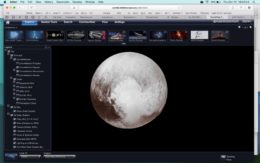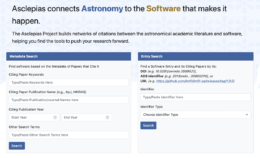AAS 240 is nearly here! The AAS Publishing team looks forward to reconnecting with meeting attendees in Pasadena and online, and we’re excited to share a preview of upcoming publishing-related sessions. Also, be sure to stop by the AAS booth in the Exhibit Hall, which will be staffed by several members of the publishing team, including Julie Steffen (AAS Chief Publishing Officer), Janice Sexton (AAS Editorial Operations Manager), and Frank Timmes (AAS Lead Editor of the High-Energy Phenomena and Fundamental Physics corridor). AAS Nova Editors Kerry Hensley and Susanna Kohler, AAS Media Fellow Haley Wahl, Astrobites Media Intern Briley Lewis, and the rest of the Astrobites team will also be available at the Astrobites booth in the Exhibit Hall.
Making the Most of AAS WorldWide Telescope
Sunday, June 12, 11:00 am PT – 12:30 pm PT | Convention Center Conference Room 204 and online
AAS WorldWide Telescope (WWT) is a tool for showcasing astronomical data and knowledge. The new “2022 edition” of the free and open-source WWT visualization software can power a wide range of initiatives like interactive “live” images in journal articles, exploratory data visualizations in Jupyter notebooks, immersive custom websites, and professional-grade planetariums. This interactive tutorial will introduce attendees to the WWT software ecosystem in the context of its applications to research, education, and public outreach. Participants should bring a laptop with battery charger and a modern web browser installed.
Make Your Research More Discoverable with a Community Supported Vocabulary: Applications of the Unified Astronomy Thesaurus
Monday, June 13, 11:00 – 11:30 am PT, Exhibit Hall Theater A/B (in person only)

An example of the interconnected concepts captured by the UAT. Click to enlarge. [Unified Astronomy Thesaurus/AAS]
Sky & Telescope Astronomy 101 Ambassadors
Monday, June 13, 1:30 – 2:00 pm PT, Exhibit Hall Theater A/B (in person only)
Join Peter Tyson, editor in chief of Sky & Telescope, and Tom Rice, the AAS education and mentoring specialist, to learn more about the AAS Sky & Telescope initiative to support Astro 101 courses and the Sky & Telescope Ambassadors program. During this presentation, you will learn about free resources to use in your classroom this year and more about a community of sharing resources related to teaching Astro 101.
Introducing WWT 2022: The Next Generation of AAS WorldWide Telescope
Monday, June 13, 5:30 – 6:00 pm PT, Exhibit Hall Theater A/B (in person only)
AAS WorldWide Telescope is a free and open-source software tool for astronomical data visualization. Its slick, interactive interface allows you to explore all sorts of astronomy data in context and overlay images, all-sky surveys, and catalogs from across the electromagnetic spectrum. Earlier this year, the WWT team released “WWT 2022,” the latest version of the WorldWide Telescope system, which is jam-packed with new features and data sets. In this presentation, you’ll learn about what WWT can do and see some of the exciting new capabilities of WWT 2022, including a new application custom-built for use in JupyterLab. Learn more about WWT 2022 at https://worldwidetelescope.github.io/editions/2022/.AAS Journals Peer Review Process with AAS Editor Brian Jackson
Tuesday, June 14, 5:30 – 6:00 pm PT, Exhibit Hall Theater A/B (in person only)
You’ve toiled for months over your LaTeX editor, cajoled your co-authors for figures, begged your advisor to give you feedback, and finally, you’re ready to submit your masterpiece to ApJ. You upload all your source files to the eJournal Press website and click the submit button.
What happens next? In this presentation, AAS science editor Brian Jackson will discuss the peer review process for the AAS Journals (ApJ, ApJS, ApJL, AJ, PSJ, and RNAAS) and answer your questions: How are referees chosen to review articles? If I’m chosen to review, what kind of feedback is the most useful? If I’m supposed to receive my referee report in three weeks, why did it take six weeks? What is “double-anonymous review,” and how does it work?
Supercharging Your Science with Software: The Asclepias Project
Wednesday, June 15, 2:00 – 3:00 pm PT | Convention Center Conference Room 204 and online
Discovery in astronomy is being driven by the development of new software tools within every aspect of our science. Be it capturing and collecting data to extracting the most science out of our ever-growing datasets to simulating the physics underlying our understanding of the universe, the development of code and software is growing as a part of how we do science and how we communicate it.The Asclepias project was born out of scientists’ need to distribute, discover, and track software as it is used in science. This tool allows you to connect the software tools and the scientific results, making your progress faster, more open, and reproducible.
In this session, we will have a demonstration of the Asclepias tools to track software and articles that use it, a panel discussion of how to supercharge your own science by finding the software tools to help you or distributing the code that you’ve written to increase its impact, and we’ll open the floor to the community to discuss the future of these efforts.



